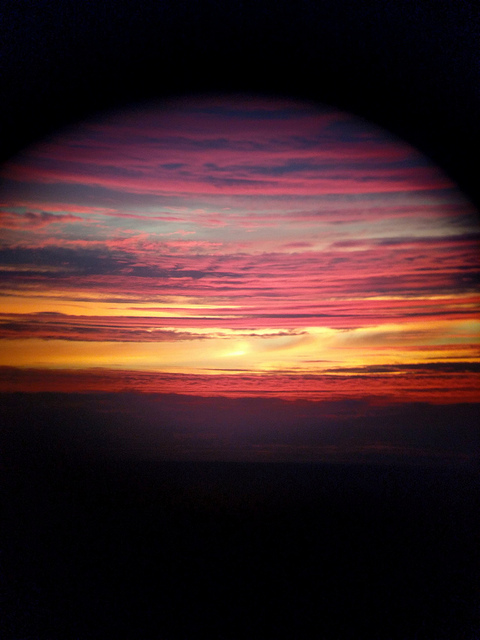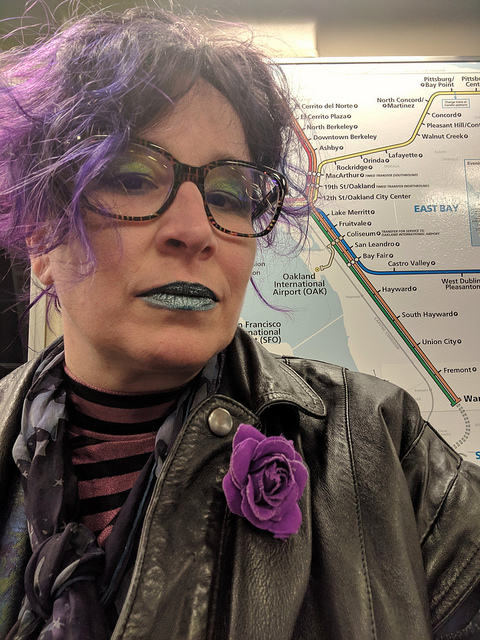The flare-ups will continue until morale improves
That’s how it works if you are Pollyanna! I am trying to be a little more active but I still can’t really leave the house except for doc appointments and I am using my manual chair inside the house for everything, still. Today I cheated and got a wheelchair van from the doctors’ office to my favorite cafe (Poesía, at 18th and Castro) for a nice sandwich in the sun at a table outside, wrote in my notebook a little, and went to Cliff’s Variety before taking the 24 home. That was actually too much but I am now in bed with my feet up for the rest of the day. My pain levels are high and I am irritable as fuck (also from the steroids), have no energy or creativity or mental oomph, can’t sit up for very long, and need to keep my feet elevated and keep icing both ankles.
This all sucks but it is also something I know how to cope with. Mostly.
Goal: get better asap and don’t end up in the CAM boots.
Smaller goal: get back to where I can do little physical therapy exercises from bed.
The construction on our house continues. We got a nifty new front gate that makes the entrance to our place more easily wheelchair accessible (at least to the back yard) and the iron worker guys are also finishing up some last touches on the handrail and footplate that goes alongside my fabulous new wheelchair ramp to the back patio and yard. It all looks fantastic. I already have been reaping the benefits of the ramp since I stopped really being able to walk at all, I can still get down the half flight of steps out front, get into my powerchair which lives in its little hidey hole and charging den under the bay window, and roll to the back yard where i can lie on a blanket in the sun. And because of the downstairs bathroom also being wheelchair accessible I can stay there all afternoon. All of that is amazing and I feel so lucky we were able to do it.
I’ll be very happy when I don’t have to deal with contractors several times a day! It has been a whole extra part time job.
One of the interesting things about the experience has been just how much I have had to argue and sit on everyone to make the accessibility work. It was never going to be actually ADA compatible but I wanted to get as close as possible. And yet every time there was a decision to make, someone would make The Absolutely Opposite of Accessible decision. No, I will NOT accept just a little inch and a half bump at the threshhold! omfg! Things like that. I had to (and am still!) pay daily attention to everything to have it not end up with access ruined unnecessarily. I guess that makes me appreciate having ADA standards more.
Reading – I re-read the first two of the Freya Marske magical Victorian smut series so that I could be caught up for the new (to me) 3rd book. They are good!
Now reading Death on the Cherwell by Mavis Doriel Hay. It starts out a little bit girls’ school jolly chums feeling, but then gets a little more complex. So far I have most appreciated how annoyed the characters are at how the newspapers refer to them as “undergraduettes”. The terrible (but very fancily printed) poetry book scene was also funny.
You can read a bit more about Mavis Doriel Hay:
https://blogs.bodleian.ox.ac.uk/oxfordtrainees/tag/mavis-doriel-hay/
https://promotingcrime.blogspot.com/2021/08/the-golden-age-mavis-doriel-hay-1894.html
I was unable to find a photo of her to add to her Wikipedia entry, alas.
I noticed a while back in this British Library Crime Classics spree that people often say “All my eye and Betty Martin” which I assumed was some sort of cockney rhyming slang. Oblomovka took offense and claimed to have never heard it before – and it turns out to be really old and strange slang!!
All my eye and Betty Martin
“In Britain during the 1700s, the phrase was a common claim of dismissal (similar to ‘nonsense’, or ‘hogwash’), or a way to declare disbelief of an absurdity. It possibly originated as the punch line of a joke (though this is likely a folk etymology). Most variations of the joke involve a British sailor visiting Italy. He overhears a Latin prayer, “Ah! [Da] mihi, beate Martine” (which translates to “Ah! Grant to me, blessed Martin”, referring to St. Martin). The sailor mishears the prayer, and later uses the phrase as “All my eye and Betty Martin”. ”
Why it is popping up in countless 1910s-1940s british detective novels, I can’t say. Maybe it never went away, or maybe it became oddly popular around then, or maybe it was a fabulous in joke of The Detection Club, which I believe Mavis Hay was part of.
Another good thing I had to look up: “tamasha” which seems to be used to mean “hullabaloo”.
I am also passing time and enduring by doing old NYT crosswords and playing the game Roots of Pacha. Roots of Pacha is like neolithic Stardew Valley, without combat and with more “puzzles” in the mines. There is also a mini game where you play the flute to wild animals to tame them & then you can breed better quality domestic animals and try to collect all their colors. The storylines and social aspect of this game is good – I am dating every romanceable villager, am married, (Poly is OK in game!) and have an infant for the first time. I have read that the children in this game actually grow up, go to “school” which probably means they will take care of some animals or crops, and then choose a profession. It is very good, and very playable.
Nothing is quite as good as Stardew though!
I may play some more breath of the wild/Tears of the Kingdom if this flare up goes much longer. Punkgeek tries to suggest new games to me which ARE good clearly but which for one reason or another I just can’t roll with (like subnautica)
I have tried my hand at most of the 30 years old sunday crosswords and then skipped up to 20 years ago. Either way it is painfully like having to inhabit The Mind of Boomers. The best bit of it, other than actually solving an entire puzzle (MUCH harder than solving today’s Sunday puzzles!!) is getting obsolete computer terms – pre-web, for the 1994-1995 puzzles, and pre-smart-phone, for the 2005 puzzles. Compounded by the east coast flavor of cluelessness about either which is always hilarious.
Oblomovka and I watched a compilation of the “Have you ever sent a fax from the beach? YOU WILL” ads from or so.
@artiv3rse
At at the time we sneered at these so hard (at least where I was sitting) for being goofy or, I don’t know. It’s hard to explain why they were cringy, but they were. For one, you are not going to want to send a fax from the beach and if you do want to, fuck off. For another somehow they were just “off”. They didn’t actually think hard enough on it, they weren’t informed enough either by the things imagined by actual computer using nerds or by science fiction things that had already been talked about for the last 50 years, etc. (which is odd because of course AT&T was full of knowledgeable nerds and researchers, though their marketing dept maybe was less so). Now, of course it is even funnier to think that not only do we do all these things but many of them are humorously obsolete as if they had predicted we would be sending morse code telegrams via Dick Tracy 2-way wrist radio from our commuter zeppelins.
I hope we really do get commuter zeppelins, still.
Other things:
* Missed going to CSUN, which I had a non refundable registration for 🙁
* helped a cousin with geneological research
* did a tiny bit of actual work last week and this week
* had a good long talk with dossie about her 2nd edition of Radical Ecstasy and am looking at her draft of a different book
* watching the end of Gilded Age with Oblomov
* Oblomov reading me bits of book 3 of Dance to the Music of Time, and bits of Hazlett “Plain Speaking” which is brilliant out loud
* talked with the waymo people about their wheelchair van service software problems
* missed several musical concerts I had tickets to and really wanted to see
* looking at my sister’s draft of some writing
* afternoon with yatima who brought me some groceries and did the dishes and was such good company
* spent a nice afternoon with my mom doing GOAT archiving work.

